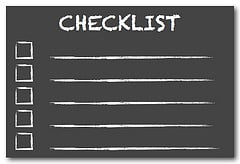 Going through a detailed checklist for your charter boat is probably not at the top of your vacation plans. But for a safe and enjoyable bareboat charter, it is a must. Arriving at your charter base is an exciting moment. But before you get carried away with your vacation plans, use this checklist to ensure that all equipment is onboard, in working order, and that you and your crewmembers understand how each system works.
Going through a detailed checklist for your charter boat is probably not at the top of your vacation plans. But for a safe and enjoyable bareboat charter, it is a must. Arriving at your charter base is an exciting moment. But before you get carried away with your vacation plans, use this checklist to ensure that all equipment is onboard, in working order, and that you and your crewmembers understand how each system works.
If you have additional items you think will help others at the start of a charter, please e-mail us, so we can add it to our charter boat checklist.
Food & Provisioning
- Check that any food or supplies you ordered from the charter company, grocery, or other provisioner is as you ordered it and in good condition.
- Double check that you have everything you need especially the basics like bathroom toiletries, liquid soap, salt and pepper, sugar, bread, butter, cooking oil and spray, ice, paper napkins, and paper towels.
- Place the food you plan to use first near the top when stowing it. Put the most perishable items near the cooling plate. But avoid putting fruits and vegetables next to the cold plate.
Refrigeration
Your charter company will run the boat’s systems prior to your arrival so you will have a cold freezer and refrigerator to stow your fresh and frozen food. It is also useful to ensure that the refrigeration is working properly. If the boat is equipped with a cold plate system, a thin layer of soft ice on the plates will tell you it is working.
Water Aboard
- Top your water tanks before leaving so that you are confident they are full. Though the charter company is supposed to fill the water tanks, mistakes happen.
- Ensure each faucet is working including the deck shower.
Dinghy
Do not discount the importance of having a fully equipped and working dinghy.
- Before leaving the dock, start the outboard and check that it spits water. If it is an inflatable, make sure it is properly inflated and that you have an air pump on the boat. Check the gasoline level. The following should be on board the dinghy:
- Fuel tank – full
- Wrist-attachable kill switch
- Bailing bucket or bilge pump
- Paddles or oars with brackets, check that the paddles are the right size
- Throwable life-saving device
- Bow line or long painter – the painter is the long rope that is attached to the dinghy for towing it, tying it to the boat or to a dock.
- Cable lock
- Flashlight
- Sound signal (whistle)
- Visual distress signals
- Spare oil, spark plugs, cotter pins, etc.
- Small dinghy anchor with 75-100ft rode
- Safety line between outboard and dinghy hull.
Anchor
- Test the windlass taking the anchor up and down a couple of times
- Check fo a snubber (bridle used to take the strain of the chain rode)
Boat Tour by Charter Company Briefer
Pay careful attention and ask questions. Preferably have another crewmember present and take notes.
- Understand and test the navigation equipment and autopilot, if applicable
- Understand how to operate the VHF radio
- Identify and operate the running, steaming, and anchor lights
- Understand the bilge pumps procedures, including manual pump
- Identify the location of flares and other signaling devices
- Identify the location and operation of fire extinguishers
- Windlass
- Electric operation
- Manual operation in case of power failure
- Location of anchor windlass reset button (if electrical system becomes overloaded)
- Location of spare anchor
- Water tank switching procedure
- Learn location of sea cocks and how to operate them
- Test the stove and operation of the propane system checking that propane tanks are full
- Familiarize yourself with the refrigeration system and refrigerator drain
- Understand the marine head(s) and holding tank procedures
- Understand the boat’s reefing procedure
- Sails
- Hoist the main a few feet to ensure it goes up and down freely
- Unfurl of the head sail a couple of turns to check it furls in smoothly
- Understand how the winches and clutches work
- Turn the helm to ensure it works freely
- Identify the location of the emergency tiller
- Identify the location of the First Aid kit (should be fully stocked)
- Identify the location of the tool box, with spare oil
- Understand power panel and batteries ensuring they are in working order and good condition
- Test 12 V outlets
- Locate the engine oil stick and cooling water tank
- Start the main engine and test the transmission, forward and reverse
- Locate fuel and water tanks deckplate keys
Weather
- Check the weather forecast and the projected trend for the remainder of your trip. Check our favorite links and resources for sailors for weather resources in various regions.
- Take note of the radio frequencies so you can check the daily weather.
- Ask the charter base staff if there is anything in particular you need to know for the duration of your sail plan such as unusual weather patterns or strong winds.
- If your charter is in a tropical storm-prone area such as in the Caribbean during the summer months, ask the charter base staff about their procedure for calling boats back to the base for a tropical weather event.
Other Details
- Flashlights work and you have replacement batteries
- Spray lubricant like WD-40
- Boat hook
- Dock lines
- Main companionway locking key
- Necessary charts and cruising guides for your sailing plan
- Personal floatation device for each crewmember including children
- A couple of windscoops for improved cabin ventilation
- Snorkeling gear on board fits crewmembers
- Boat documentation and cruising permits (if necessary)
- Confirm with each crewmember that they have properly stowed everything and left nothing loose in the cabins
- If you plan to visit several different islands, have several copies of your crew list so you don’t to rewrite the same information each time you change countries.
- Check for special events in your area.
- If this is one of the first times you are bareboat chartering, plan a short sailing leg the first day in order to be at the anchorage by 15:00.
While you may be tempted to rush through the checklist, take your time to ensure you understand each item. The extra time spent up front will make you feel and be safer and more confident during your sail.





